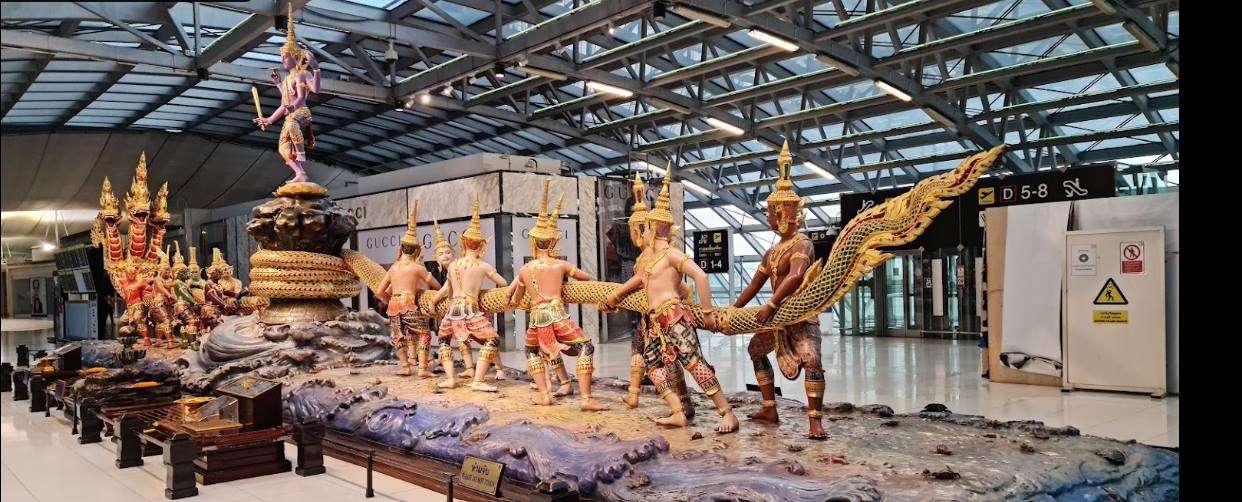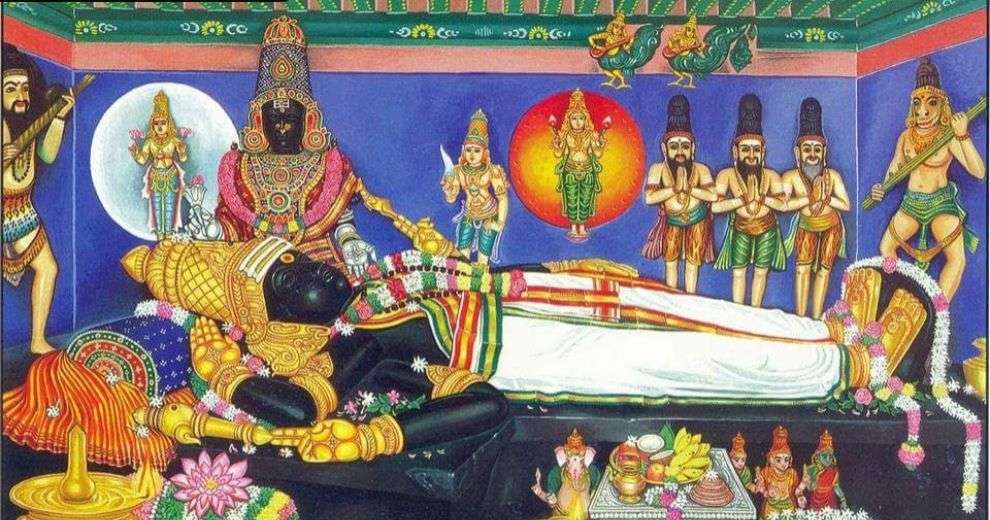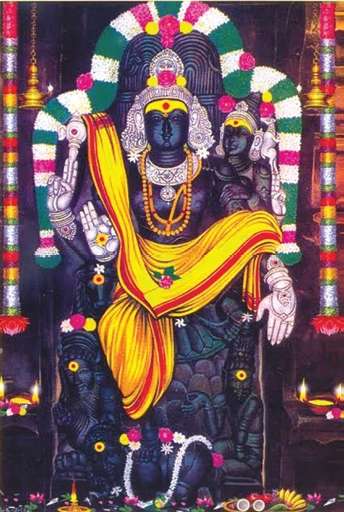Table of Contents
ToggleSurutapalli
Sri Pallikondeswara Swamy - Surutapalli - Where Lord Siva Rests his head on Goddess Parvati's Lap
Source - Article written by Sri Girish Muralidhar - Saptagiri Magazine
Churning of the ocean
One of the most prominent among Puranic episodes is the churning of the ocean. It is so prominent that references to it are found in far-off places where once Hinduism flourished.
Those with a keen eye would be able to recall this incident recreated in the Suvarnabhumi airport in Thailand which has an almost life-like exhibit of the occurrence, with the Devas on one side and Asuras on the other, with the Meru mountain used as the churning rod.

Meru mountain
Geographical indicators across India point us to this having taken place in Tamil Nadu. The mouth of the Paalar river (Paal/Paalu in Tamil and Telugu denoting milk), where it meets the Bay of Bengal is said to be the place where this incident took place.
The Meru mountain is said to have been the mountain Tirukazhukundram where Shiva is said to manifest as 'Vedagireeshwarar'.
We all know that in the story of the churning, multiple things emerge from the sea. The divine horse Uchchaishravas, the divine tree Kalpavrisksha, and Mahalakshmi herself, amongst many others came out. We also know that before the god of medicine Dhanvantri emerged with the Amrita, there was the great poison Halahala had emerged.
Adi Shankara Bhagavatpada in his Dashashloki Stuti beautifully captured the moment where Lord Shiva comes to rescue the whole world, by saying ‘They, i.e. all living things are dependent on me for protection, Yo Raksha Dardhakshanaat’ earning the name Pashupati.

Sri Pallikondeswara Swamy and Sarvamangalambika Devi
After drinking the poison, Lord Shiva is said to have walked away with the Devas and Asuras resuming their activity. Some say that the poison was so difficult for Shiva to bear, that after traveling a little, he asked Parvati to sit and he rested on her lap. This is said to have taken place near a place we call now 'Surutapalli'.
While it is well known that Vishnu is the one who reclines in the ocean of milk upon Adisesha, this is a rare instance where one can find Lord Shiva doing so, earning the name 'Pallikondeswara'.
Devi Parvati here is known as 'Sarvamangalambika', as she is said to be the one who not only held Shiva’s throat ensuring the poison does not enter his being but also acts as the one who is the provider of medicines.
There are a few rarities present in this temple. In most Shiva temples in South India, one can find Dakshinamurthy idol in the southern direction facing part of the Prakaraal.
Examples are
In some places, there is a uniqueness present to it. A couple of examples are
- Thiruvaiyaru in Tamil Nadu, where he is known as Shiva Yoga Dakshinamurthy, with a Trishul in hand and a tortoise at his feet.
- Another is Thirupulivanam, also in Tamil Nadu where Dakshinamurthy is depicted as an Ardhanarishwara.
- In Surutapalli, one finds Dakshinamurthy along with Devi Parvati herself, earning the epithet Dampatya Dakshinamurthy (Dakshinamurthy couple).
Dampatya Dakshinamurthy
This is unique, as Dakshinamurthy in astrological terms represents Guru, Santana bhagyam, and money. Shukra (graha) is said to represent marriage and luxury. Guru and Shukra even in astrological terms are not always said to see eye to eye, and they are preceptors of the Devas and Asuras respectively, who are forever fighting.
But in Surutapalli, their joint powers manifest in the Dampatya Dakshinamurthy idol, where they bless couples with long married lives, and also with children. Some say that it is Brihaspati along with his wife Tara, whereas some say it is Shiva himself with Parvati.

Valmikeshwara Swami (Main Deity)
Further, inside the temple, the Moolamurthy, which is the main deity resides in Surutapalli, known as Valmikeshwara, in a triangular form being Swayambhu Lingam. Valmikeshwara is the original deity of this Kshetram and precedes the churning of the ocean and was worshipped by Valmiki before he began composing the Ramayanam, hence the name.
While the shrine of Shiva in any temple is usually guarded by Dwarapalakas, in this temple they are guarded by Kubera’s companions, namely Shankanidhi and Padmanidhi.
The Moolamurthy’s consort is Devi Parvati by name Marakathambika. Opposite Marakathambika is her son Vinayaka, who is entirely made of Shaligrama stone.
Ganesha too is said to be here with his consorts Riddhi Devi and Siddhi Devi. Here, Lord Subramanya with his consorts Valli and Devasena is also said to face south, assuring devotees by ridding them of the fear of death (Maranabhayam).
The practice of observing Pradosha and the cessation of Vedic studies typically on Pradosha and the three days preceding. It is said to have begun from the time Lord Shiva drank the poison. Dashami is when the poison is said to have emerged, it was Ekadashi when Lord Shiva drank the poison and rescued the world.
Dwadashi was when the churning of the ocean concluded, and the gods realized that they did not bother to enquire about Shiva. That is when on Trayodashi they saw him in Surutapalli – Some say reclining, some say performing the Ananda Tandavam. It is in memory of these cosmic incidents, that the next day is celebrated as Maha Shiva Ratri, and the day when the Devas went to enquire about Shiva’s wellbeing is venerated as Pradosham.
One can observe that the Ekadashi before Maha Shiva Ratri is named Vijaya Ekadashi, indicating the day Devas celebrated their victory. The 4 days of the Kumbha month (as per solar astrology) are said to be the most auspicious time of the year – An indicator of god’s infinite mercy upon us when he drank deadly poison, and by subduing it, allowed all things to live.
